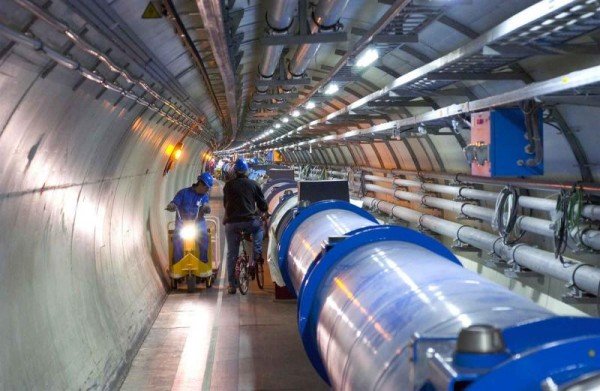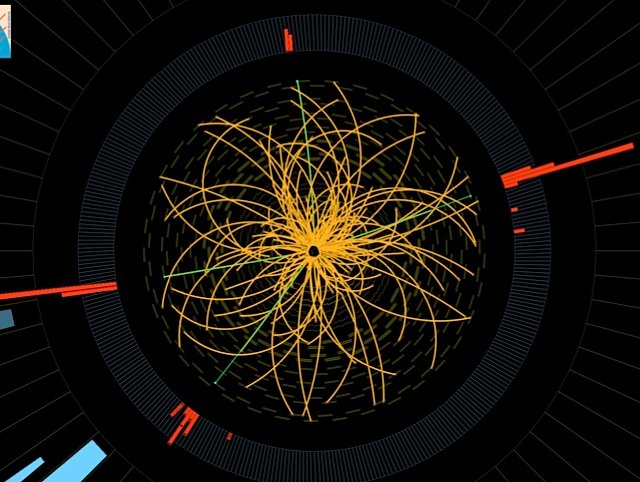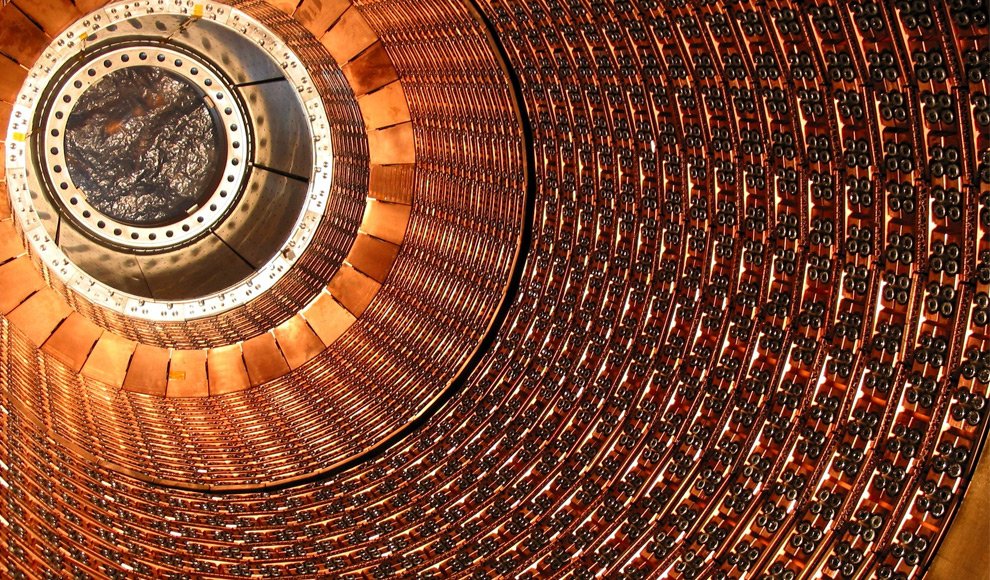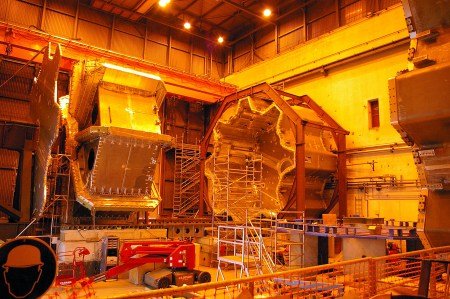Home Tags Posts tagged with "large hadron collider"
large hadron collider
CERN’s Large Hadron Collider (LHC) has restarted, with protons circling the machine’s 27km tunnel for the first time since 2013.
Particle beams have now travelled in both directions, inside parallel pipes, at a whisker below the speed of light.
Actual collisions will not begin for at least another month, but they will take place with nearly double the energy the LHC reached during its first run.
Scientists hope to glimpse a “new physics” beyond the Standard Model.
CERN’s Director General Rolf Heuer told engineers and scientists at the lab: “Congratulations. Thank you very much everyone… now the hard work starts.”
CERN’s director for accelerators and technology, Frédérick Bordry, said: “After two years of effort, the LHC is in great shape.
“But the most important step is still to come when we increase the energy of the beams to new record levels.”
[youtube 1Mpq_94YGco 650]
Prof. Peter Higgs has revealed he did not know he had won the Nobel Prize until a woman congratulated him in the street.
Prof. Peter Higgs, 84, who does not own a mobile phone, said a former neighbor had pulled up in her car as he was returning from lunch in Edinburgh.
He added: “She congratulated me on the news and I said <<oh, what news?>>”
The woman had been alerted by her daughter in London that Prof. Peter Higgs had won the award, he revealed.
He added: “I heard more about it obviously when I got home and started reading the messages.”
The emeritus professor at the University of Edinburgh was recognized by the Royal Swedish Academy of Sciences for his work on the theory of the particle which shares his name, the Higgs boson.
Prof. Peter Higgs shares this year’s physics prize with Francois Englert of Belgium, and joins the ranks of past Nobel winners including Marie Curie and Albert Einstein.

Prof. Peter Higgs has revealed he did not know he had won the Nobel Prize until a woman congratulated him in the street
The existence of the so-called “God particle”, said to give matter its substance, or mass, was proved almost 50 years later by a team from the European nuclear research facility (CERN) and its Large Hadron Collider (LHC) in Geneva, Switzerland.
Speaking for the first time about the award at a media conference at the University of Edinburgh, he said: “How do I feel? Well, obviously I’m delighted and rather relieved in a sense that it’s all over. It has been a long time coming.”
An old friend told him he had been nominated as far back as 1980, he said.
Prof. Peter Higgs added: “In terms of later events, it seemed to me for many years that the experimental verification might not come in my lifetime.
“But since the start up of the LHC it has been pretty clear that they would get there, and despite some mishaps they did get there.”
Stressing the involvement of other theorists and CERN, he added: “I think clearly they should, but it is going to be even more difficult for the Nobel Committee to allocate the credit when it comes to an organization like CERN.
“I should remind you that although only two of us have shared this prize, Francois Englert of Brussels and myself, that the work in 1964 involved three groups of people, (including) two in Brussels.
“Unfortunately Robert Brout died a few years ago so is no longer able to be awarded the prize, but he would certainly have been one of the winners if he had still been alive.
“But there were three others who also contributed and it is already difficult to allocate the credit amongst the theorists.
“Although a lot of people seem to think I did all this single-handed, it was actually part of a theoretical programme which had been started in 1960.”
Prof. Peter Higgs was born in Newcastle, but developed his theory while working at the University of Edinburgh.
The landmark research that defined what was to become known as the Higgs boson was published in 1964.
Discovering the particle became one of the most sought-after goals in science, and the team of scientists behind the $10 billion LHC at CERN made proving its existence a key priority.
In July of last year, physicists at CERN confirmed the discovery of a particle consistent with the Higgs boson.
Prof. Peter Higgs, who had often been uncomfortable with the attention his theory brought, was in Geneva to hear the news, and wiped a tear from his eye as the announcement was made.
Reacting to the discovery at the time, Prof. Peter Higgs told reporters: “It’s very nice to be right sometimes.”
CERN scientists reporting at conferences in the UK and Geneva, Switzerland, claim the discovery of a new particle consistent with the Higgs boson.
The particle has been the subject of a 45-year hunt to explain how matter attains its mass.
Both of the two Higgs-hunting experiments at the Large Hadron Collider have reached a level of certainty worthy of a “discovery”.
More work will be needed to be certain that what they see is a Higgs, however.
Both teams claimed they had seen a “bump” in their data corresponding to a particle weighing in at about 125-126 gigaelectronvolts (GeV) – about 130 times heavier than the proton at the heart of every atom.
The results announced at CERN, home of the LHC in Geneva, were each met with thunderous applause.

CERN scientists reporting at conferences in the UK and Geneva claim the discovery of a new particle consistent with the Higgs boson
Prof. Peter Higgs, the former University of Edinburgh theoretician who with five others predicted the Higgs particle’s existence in 1964, praised the LHC teams, calling the results “a testament to the expertise of the researchers”.
“I never expected this to happen in my lifetime and shall be asking my family to put some champagne in the fridge,” he said.
The CMS team claimed that by combining two of its data sets, they had attained a confidence level just at the “five-sigma” point – about a one-in-3.5 million chance that the signal they see would appear if there were no Higgs particle.
However, a full combination of the CMS data brings that number just back to 4.9 sigma – a one-in-2 million chance.
Joe Incandela, spokesman for CMS, was unequivocal.
“The results are preliminary but the five-sigma signal at around 125 GeV we’re seeing is dramatic. This is indeed a new particle,” he told the Geneva meeting.
Fabiola Gianotti, spokeswoman for the ATLAS experiment, announced even more irrefutable results.
“We observe in our data clear signs of a new particle, at the level of five sigma, in the mass region around 126 GeV,” she said.
Anticipation had been high and rumors were rife before the announcement.
Indications are strong, but it remains to be seen whether the particle the team reports is in fact the Higgs – those answers will certainly not come on Wednesday.
A confirmation would be one of the biggest scientific discoveries of the century; the hunt for the Higgs has been compared by some physicists to the Apollo programme that reached the Moon in the 1960s.
Two different experiment teams at the LHC observe a signal in the same part of the “search region” for the Higgs – at a rough mass of 125 GeV.
Hints of the particle, revealed to the world by teams at the LHC in December 2011, have since strengthened markedly.
The $10 billion LHC is the most powerful particle accelerator ever built: it smashes two beams of protons together at close to the speed of light with the aim of revealing new phenomena in the wreckage of the collisions.
The ATLAS and CMS experiments, which were designed to hunt for the Higgs at the LHC, each detect a signal with a statistical certainty of more than 4.5 sigma.
Five sigma is the generally accepted benchmark for claiming the discovery of a new particle. It equates to a one in 3.5 million chance that there is no Higgs and the “bump” in the data is down to some statistical fluctuation.
Prof. Stefan Soldner-Rembold, from the University of Manchester, said earlier this week: “The evidence is piling up… everything points in the direction that the Higgs is there.”
The Higgs is the cornerstone of the Standard Model – the most successful theory to explain the workings of the Universe.
But most researchers now regard the Standard Model as a stepping stone to some other, more complete theory, which can explain phenomena such as dark matter and dark energy.
Once the new particle is confirmed, scientists will have to figure out whether the particle they see is the version of the Higgs predicted by the Standard Model or something more exotic.
Scientists will look at how the Higgs decays or – transforms – into other, more stable particles after being produced in collisions at the LHC.
The Standard Model is the simplest set of ingredients – elementary particles – needed to make up the world we see in the heavens and in the laboratory
• Quarks combine together to make, for example, the proton and neutron – which make up the nuclei of atoms today – though more exotic combinations were around in the Universe’s early days
• Leptons come in charged and uncharged versions; electrons – the most familiar charged lepton – together with quarks make up all the matter we can see; the uncharged leptons are neutrinos, which rarely interact with matter
• The “force carriers” are particles whose movements are observed as familiar forces such as those behind electricity and light (electromagnetism) and radioactive decay (the weak nuclear force)
• The Higgs boson came about because although the Standard Model holds together neatly, nothing requires the particles to have mass; for a fuller theory, the Higgs – or something else – must fill in that gap
Scientists at CERN in Switzerland will announce that the elusive Higgs boson “God Particle” has been found at a press conference next week, according to new reports.
Five leading theoretical physicists have been invited to the event on Wednesday – sparking speculation that the particle has been discovered.
Scientists at the Large Hadron Collider are expected to say they are 99.99% certain it has been found – which is known as “four sigma” level.
Physicists first predicted that the Higgs Boson subatomic particle exists 48 years ago.
Peter Higgs, the Edinburgh University emeritus professor of physics that the particle is named after, is among those who have been called to the press conference in Switzerland.

Scientists at CERN in Switzerland will announce that the elusive Higgs boson “God Particle” has been found at a press conference next week
The management at CERN wants the two teams of scientists to reach the “five sigma” level of certainty with their results – so they are 99.99995% sure – such is the significance of the results.
The Higgs boson is regarded as the key to understanding the universe. Physicists say its job is to give the particles that make up atoms their mass.
Without this mass, these particles would zip though the cosmos at the speed of light, unable to bind together to form the atoms that make up everything in the universe, from planets to people.
The collider, housed in an 18-mile tunnel buried deep underground near the French-Swiss border, smashes beams of protons – sub-atomic particles – together at close to the speed of light, recreating the conditions that existed a fraction of a second after the Big Bang.
If the physicists’ theory is correct, a few Higgs bosons should be created in every trillion collisions, before rapidly decaying.
This decay would leave behind a “footprint” that would show up as a bump in their graphs.
However, despite 1,600 trillion collisions being created in the tunnel – there have been fewer than 300 potential Higgs particles.
Now it is thought that two separate teams of scientists, who run independent experiments in secret from each other, have both uncovered evidence of the particle.
However, the two groups, CMS and ATLAS, are expected to stop short of confirming its existence.
IBM is developing a computer which will digest twice as much information every day as the entire internet, sifting through radio waves from space in an effort to unravel the origin of the universe.
The huge computer will be attached to a 1,900 square mile array of telescope antenna, and will be built to “suck in” in radio telescope data which will “see” 13 billion years into the past, back to the dawn of the universe and the Big Bang.
IBM machine will be millions of times more powerful than the fastest PCs today – and will deal with 100 times more information than the output of the Large Hadron Collider.
Ton Engbersen of IBM resarch said: “If you take the current global daily Internet traffic and multiply it by two, you are in the range of the data set that the Square Kilometre Array radio telescope will be collecting every day.”
Upon completion in 2024, the telescope will be used to explore evolving galaxies, dark matter and even the very origins of the universe dating back more than 13 billion years.

The IBM computer will be attached to a 1,900 square mile array of telescope antenna, and will be built to “suck in” in radio telescope data which will “see” 13 billion years into the past
IBM is to investigate using 3D “stacks” of computer chips to achieve the enormous computing power required by the Square Kilometre Array.
This extremely powerful survey telescope will have millions of antennas to collect radio signals, forming a collection area equivalent to one square kilometre but spanning a huge surface area – approximately the width of the continental United States.
The SKA will be 50 times more sensitive than any former radio device and more than 10,000 times faster than today’s instruments.
The SKA is expected to produce a few Exabytes of data per day for a single beam per one square kilometer. After processing this data the expectation is that per year between 300 and 1500 Petabytes of data need to be stored.
In comparison, the approximately 15 Petabytes produced by the large hadron collider at CERN per year of operation is approximately 10 to 100 times less than the envisioned capacity of SKA.
The directors of the SKA project are to meet in Amsterdam on 3 April to discuss the location of the huge telescope, scattered across 1,900 square miles of Earth’s surface.
It will start building in 2016.
“It will have a deep impact on the way we perceive our place in the universe and how we understand its history and its future,” said Michiel van Haarlem, interim director general of the SKA project.
“We know we are going to discover things.”
The SKA will consist of thousands of dishes across 1,900 miles, with a total surface area of one square kilometre, that will provide so much data that one astronomer has declared it will completely change our view of the universe.
The scientific community also believe that the SKA represents our best ever chance of finding out if there’s life beyond our solar system.
To do this will require ground-breaking technology. The SKA’s 15m-dishes, which will detect electromagnetic radiation emitted by objects in space, will be the most sensitive ever built – able to detect an airport radar on a planet 50 light years away.
These dishes will be complemented by low and medium frequency aperture arrays, which provide a large field of view and are capable of observing more than one part of the sky at once.
It will be carried on enough optical fibre cable of such quantity that it could be wrapped twice around the world.
As yet, a location for it hasn’t been decided, but Southern Africa and Australia are both n the reckoning.
They all offer areas with ideal conditions for telescopes, which must be well clear of electronic interference, such as that generated by mobile phones.
It’s hoped that construction will begin in 2016, with the dishes coming online eight years later.
A prototype of SKA called KAT-7, which consists of seven 16-metre dishes, is undergoing testing in South Africa’s Karoo desert.
A strange metal sphere that looks like a prop from a science fiction film fell to the ground in a remote area of northern Namibia, Africa, and nobody can explain where it came from.
The metallic sphere weighs around 13 lbs, has a diameter of 14 inches and its rough surface looks like “two halves welded together”, said police forensics director Paul Ludik.
When the ball came down it caused a crater 12 inches deep and 13 ft wide, although it was found some 60f t away.
Locals claimed to have heard several explosions in the days before it was discovered by a farmer on his land.

The metallic sphere weighs around 13 lbs, has a diameter of 14 inches and its rough surface looks like “two halves welded together”
The find sparked speculation on the internet that it could finally be proof of extra terrestrial life, even though it bore a passing resemblance to the head of a character from the children’s series Teletubbies.
Some claimed that it could be an escaped particle from the Large Hadron Collider, reindeer droppings or a Quaffle from the Harry Potter films.
Others – arguably with more accuracy – guessed it was a hydrazine tank, which are used on space satellites to store the flammable chemical.
Paul Ludik however was quick to point out that more tests need to be done and that NASA and the European Space Agency had been notified.
He said that the ball was discovered a month ago but it has only now been made public. Whilst it was made of a “sophisticated material”, it was something that was known to mankind.
Paul Ludik explained that the explosion heard by locals could have been the sonic boom when it broke the sound barrier coming down to Earth, or by the impact on the ground.
The compound appeared to be a “metallic compound normally used in space vehicles”, although he would not be surprised it it was actually from a normal aircraft.
Police deputy inspector general Vilho Hifindaka added that the sphere, which landed 480 miles from the Namibian capital Windhoek, did not pose any danger.
Vilho Hifindaka said: “It is not an explosive device, but rather hollow, but we had to investigate all this first”.
Earlier this year Britain and the rest of the world was put on alert when one of NASA’s satellites broke up and crashed to Earth.
Huge chunks of titanium up to 350lbs from car-sized Upper Atmosphere Research Satellite tore through the atmosphere at 1,800 mph but the best NASA could guess was that they landed somewhere south of Inverness on the equator.
To try and reassure the public it also revealed that the odds of being hit were one in 3,200 – more likely than getting a hole-in-one in golf.
Weeks later Germany’s Roentgen satellite crashed to Earth and split up into 30 huge chunks including one which weighed 880 lbs.
Large Hadron Collider’s detector Atlas captured a particle that physicists had suspected to exist for years, but had never seen “in the wild”.
The Chi b (3P) particle was detected among data from the trillions of collisions at the LHC.
The CERN discovery was hailed as testimony to how effectively physicists were now scanning the collision data – and essential background to the LHC’s ongoing quest for the Higgs, a theoretical particle which is thought to “explain” why the universe has mass.
Physicists scan the data from the LHC’s detectors for “unusual” signals from the debris of high-energy collisions. This new particle is an important milestone for the collider – and a crucial step in its mission to fill in the gaps in our understanding of physics.
Professor Stefan Soldner-Rembold, a particle physicist at the University of Manchester said the Higgs “will always be the Nobel Prize”, but that this discovery is still very exciting.
What’s been discovered, Prof. Stefan Soldner-Rembold explained, is a particle comprised of a bottom quark and a bottom anti-quark – an entirely new kid on the sub-atomic block that until now was merely a theory.
He said: “It’s exciting confirmation of the theory of strong interactions that keeps these particles together, the same theory that describes how a nucleus sticks together.
“What they’ve found is a b-quark and an anti b-quark.
“Quarks cannot be seen by themselves, they’re contained in a particle and held together with the strong force. If you understand how the force works, you can predict which particles should exist.
“With all these different quarks you can play Lego and put them together in different ways and form new particles, similar to protons, that can be combined to form elements.”

Large Hadron Collider’s detector Atlas captured a particle that physicists had suspected to exist for years, but had never seen “in the wild”
The results were put online on the scientific publication site ArXiv.
The find is an important step for the LHC – which is more than a machine built solely to hunt for the Higgs boson.
Finding particles such as Chi b (3P) is crucial to filling in the gaps in the Standard Model – the way we understand physics.
The LHC was designed to fill in these gaps – and help physicists “move on” to the Higgs and “new physics”.
A senior CERN physicist from Switzerland has announced this afternoon firm evidence for the existence of the elusive Higgs Boson, or God particle.
Although the signal doesn’t meet strict scientific standards for a “full scientific discovery”, it’s still enough for researchers at CERN’S Large Hadron Collider (LHC) to predict a discovery next year.
Two separate teams of scientists have been running independent experiments in secret from each other in order to improve the veracity of the results with the team leader of one, Fabiola Gianotti, proclaiming that they believe they’ve found signs of the Higgs boson in the past year.
“We have built a solid foundation for the months ahead,” Fabiola Gianotti said.
However, CERN was cautious: “The main conclusion is that the Standard Model Higgs boson, if it exists, is most likely to have a mass constrained to the range 116-130 GeV [a unit of energy equal to billion electron volts] by the ATLAS experiment, and 115-127 GeV by CMS.
“Tantalizing hints have been seen by both experiments in this mass region, but these are not yet strong enough to claim a discovery.
“Higgs bosons, if they exist, are very short lived and can decay in many different ways. Discovery relies on observing the particles they decay into rather than the Higgs itself. Both ATLAS and CMS have analyzed several decay channels, and the experiments see small excesses in the low mass region that has not yet been excluded.”
The upshot of the experiments, therefore, is that researchers believe the Higgs is fairly lightweight, which could lead to more exciting discoveries, according to New Scientist’s Lisa Grossman.
Lisa Grossman wrote: “A Higgs of this mass, about 125 gigaelectronvolts, would blast a path to uncharted terrain. Such a lightweight would need at least one new type of particle to stabilize it.”

A senior CERN physicist from Switzerland has announced this afternoon firm evidence for the existence of the elusive Higgs Boson, or God particle
When looking at results, the scale of certainty used by researchers is the sigma, something peculiar to particle physics.
Researchers need a five-sigma level of certainty to make a bona-fide formal discovery, which means there’s only a one in a million chance that the result is a statistical error.
Scientists only formally acknowledge an experiment’s results if they hit a three sigma level, which means there’s only a 1 in 370 chance of them being a fluke.
The sigma probabilities announced today for the Higgs hunt have not been combined, but the overall ATLAS result was 2.3.
Before the press conference began, CERN described the room as “full to the rafters. People would hang from the lamps if the security guards would let them”.
The Higgs boson is regarded – by those who know about such things – as the key to understanding the universe. Its job is, apparently, to give the particles that make up atoms their mass.
Without this mass, these particles would zip though the cosmos at the speed of light, unable to bind together to form the atoms that make up everything in the universe, from planets to people.
The Higgs boson’s existence was predicted in 1964 by Edinburgh University physicist Peter Higgs. But it has eluded previous searchers – so much so that not all scientists believe in its existence.
The hunt for the Higgs boson was one of the LHC’s major tasks.
The collider, housed in an 18-mile tunnel buried deep underground near the French-Swiss border, smashes beams of protons – sub-atomic particles – together at close to the speed of light, recreating the conditions that existed a fraction of a second after the Big Bang.
If the physicists’ theory is correct, a few Higgs bosons should be created in every trillion collisions, before rapidly decaying.
This decay would leave behind a “footprint” that would show up as a bump in their graphs.
The CMS – or Compact Muon Solenoid – is a 13,000-ton machine that sits 330 feet underground, while the ATLAS, at 148 feet long and 82 feet high, is the biggest detector ever constructed.
From the Big Bang to the 1960s
The existence of the Higgs boson was put forward in the 1960s to explain why the tiny particles that make up atoms have mass.
Theory has it that as the universe cooled after the Big Bang, an invisible force known as the Higgs field formed.
This field permeates the cosmos and is made up of countless numbers of tiny particles – or Higgs bosons.
As other particles pass through it, they pick up mass.
Any benefits in the wider world from the discovery of the Higgs boson will be long term, but they could be felt in fields as diverse as medicine, computing and manufacturing.
Experts compare the search for the Higgs boson to the discovery of the electron.
The idea of the electron – a subatomic particle – was first floated in 1838, but its presence was not confirmed for another 60 years.
A century on, the electron’s existence underpins modern science. Our understanding of it is critical to the development of technology from television and CDs to radiotherapy for cancer patients
Sources with close contacts inside CERN in Switzerland predicted this weekend that sighting of the first strong signs of a particle vital to support Einstein’s ideas of the universe will be reported on Tuesday.
The scientists warned that there would be no announcement of a full scientific discovery – but even confirmation that something like the long-sought Higgs boson had been spotted would be a major advance. The God particle is believed to have given shape to the universe after the Big Bang 13.7 billion years ago.
Oliver Buchmueller, a senior member of one of the two teams seeking the particle in CERN’s Large Hadron Collider (LHC) this year, said: “I am feeling quite a level of excitement.”
Two separate LHC teams – using the ATLAS and CMS detectors – have smashed protons in 350 trillion collisions this year, hoping to see the Higgs particle in the debris.
Science bloggers with close contacts among the tight-lipped front-line research groups, known as ATLAS and – Buchmueller’s – CMS, said their understanding was that both had found signals that look very much like the Higgs particle.
“The anticipation among physics enthusiasts is almost palpable,” said theoretician Sascha Vongehr on his blog, www.science20.com. The observation of a “light Higgs” would be announced at a December 13 CERN seminar, he said.
Rolf Heuer, CERN’s director general, revealing the seminar would be given updates on the Higgs search by the heads of the ATLAS and the CMS groups who work independently and in secret from each other, said there would be no discovery announcement.
For that, there would have to be a high degree of certainty – measured at 5 sigma, in scientific terms, or a 0.00003 per cent chance of error- by both.

The observation of a “light Higgs” would be announced at a December 13 CERN seminar
Informed bloggers are saying it is hovering at about 2.5 sigma for CMS and 3.5 for ATLAS – enough to qualify the sightings as “an observation” – both would correspond to a probability above 95 per cent that the observations are accurate.
But, said Oliver Buchmueller, without confirming that reading for his own team, if the ATLAS group had found signals similar to those seen in CMS, “then we’re moving very close to a conclusion in the first few months of next year”.
The Higgs particle is essentially a missing piece of the “Standard Model” of physics jigsaw, which explains how the universe is glued together.
So far, it’s the only elementary particle predicted by this model that scientists have not been able to create with atom smashers.
The director general of CERN, Rolf Heuer, said recently that he doesn’t think confirmation of the particle’s existence will be made until around October 2012.
But Professor John Ellis, a former head of theoretical physics at CERN, told the BBC that he expects to see the “first glimpse” of the God particle this week.
Prof. John Ellis said: “There seem to be some hints emerging there… and that’s what we’re going to learn on Tuesday.”
The veracity of the results has been ensured by two separate teams, each comprising of hundreds of researchers, searching using different experiments.
One team, using scientists from 169 universities, has been working on the ATLAS detector, which at 148 feet long and 82 feet high, is the biggest ever constructed.
The other is using the CMS – or Compact Muon Solenoid – a 13,000-ton detector that sits 330 feet underground.
There are some scientists, however, who have poured cold water on the news, with Nobel Prize winner Martinus Veltman from the Universities of Michigan and Utrecht telling the Guardian that “there is no Higgs”.
[youtube qQNpucos9wc]
The first signs of the ultra-elusive Higgs boson particle have been detected by teams working at CERN’s Large Hadron Collider (LHC) in Switzerland.
Existence of Higgs boson particle – believed to have given shape to the universe after the Big Bang 13.7 billion years ago – was proposed some four decades ago.
Two separate LHC teams – using the ATLAS and CMS detectors – have smashed protons in 350 trillion collisions this year, hoping to see the Higgs in the debris.
The CERN scientists are now reporting that “significant progress” has been made in tracking it down with a big press conference taking place next Tuesday in which the teams will announce what they’ve found.
Needless to say, the world of physics is breathless with excitement at this news.
The Higgs particle is essentially a missing piece of the “Standard Model” of physics jigsaw, which explains how the universe is glued together.
So far, it’s the only elementary particle predicted by this model that scientists have not been able to create with atom smashers.
Rolf Heuer, general director of CERN, said recently that he doesn’t think confirmation of Higgs boson particle’s existence will be made until around October 2012.

Two separate LHC teams – using the ATLAS and CMS detectors – have smashed protons in 350 trillion collisions this year, hoping to see the Higgs in the debris
However, reports from inside the LHC suggest that its scientists are on the brink of something monumental, with Professor John Ellis, a former head of theoretical physics at CERN, telling the BBC that he expects to see the “first glimpse” of the God particle next week.
Prof. John Ellis said: “There seem to be some hints emerging there… and that’s what we’re going to learn on Tuesday.”
The veracity of the results has been ensured by two separate teams, each comprising of hundreds of researchers, searching using different experiments.
One team, using scientists from 169 universities, has been working on the ATLAS detector, which at 148 feet long and 82 feet high, is the biggest ever constructed.
The other team is using the CMS – or Compact Muon Solenoid – a 13,000-ton detector that sits 330 feet underground.
However, there are some scientists, who have poured cold water on the news, with Nobel Prize winner Martinus Veltman from the Universities of Michigan and Utrecht telling the Guardian that “there is no Higgs”.
[youtube qQNpucos9wc]
Physicists from CERN, Swiss, ran again the test that had proved the theory of relativity was wrong – and broke the speed of light for a second time.
Scientists of the Large Hadron Collider sent another beam of subatomic particles over 450 miles to a laboratory in Gran Sasso in the Italian Alps.
And after running the modified follow-up test 20 times, the scientists recorded exactly the same results as before.
According to Albert Einstein’s 106-year-old theory of special relativity, nothing can travel faster than light in a vacuum because its particles have no mass.
By contrast, neutrinos – said to be “ghostly” because they can travel through anything – have a very small mass.

Physicists from CERN, Swiss, ran again the test that had proved the theory of relativity was wrong – and broke the speed of light for a second time
The Cern researchers apparently record-breaking speed raises a host of possibilities straight out of science fiction stories.
Critics of the first test said that running all 15,000 neutrinos at once meant there could be errors in the measurement that said they had beaten the speed of light by 60 nanoseconds (or billionths of a second).
The scientists claim to have used a more accurate method for the second trial, by sending shorter bunches of the tiny neutrinos with larger gaps in between.
Nuclear Physics at Gran Sasso said the researchers were now “more confident” about the result, but urged other laboratories to join his in repeating the test.
“A measurement so delicate and carrying a profound implication on physics requires an extraordinary level of scrutiny.”
Many experts still remain unconvinced.
Jim Al-Khalili, of the University of Surrey’s physics department, who has offered to eat his boxer shorts on live television if neutrinos really can travel faster than light, said:
“I am not yet ready to get out my knife and fork.
“The results have only dealt with some possible errors.
“There are still a number of other possible errors and uncertainties that they are working on ruling out.
“Ideally, the experiment would have to be done somewhere else entirely to try to verify the controversial result that these tiny particles really are going faster than light, in case there is still a systemic problem with this particular experiment at Cern.”
Only two other labs in the world have the equipment to take up Professor Jim Al-Khalili’s suggestion.
Scientists working on the Minos experiment in the U.S. and Japan’s T2K study will both try the same test and reveal their results next year.











